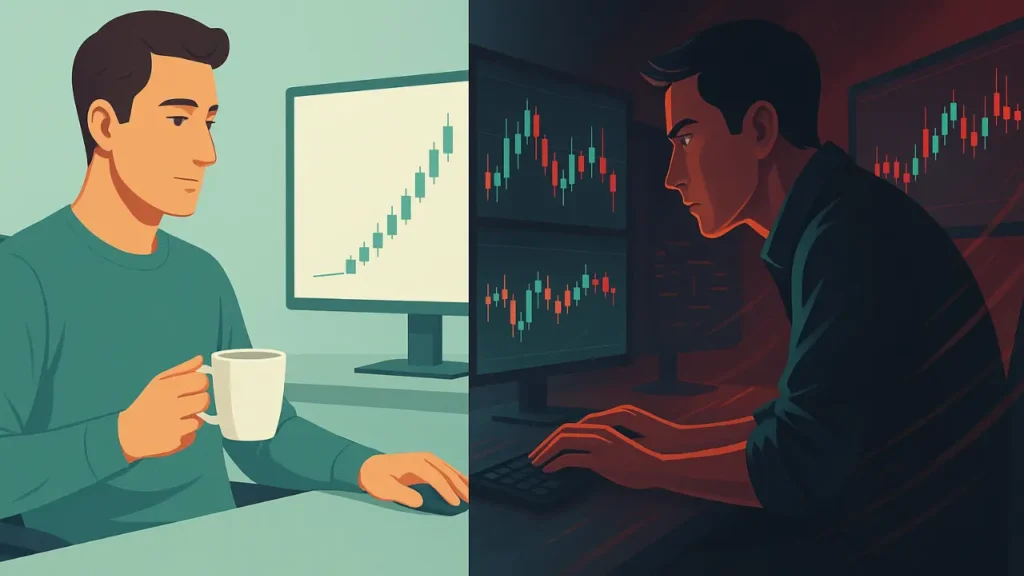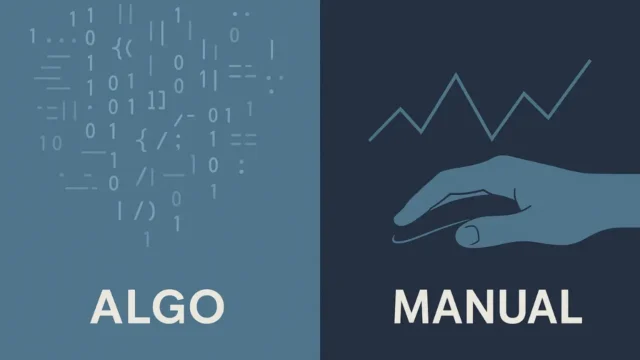Follow Us
Swing Trading vs Scalping: Which is Better?

Table of Contents
- Key Takeaways
- Overview of Swing Trading
- Overview of Scalping
- Brief History & Market Context
- Key Differences Between Swing Trading and Scalping
- Pros & Cons of Swing Trading
- Pros & Cons of Scalping
- Tools & Indicators Commonly Used
- Who Should Choose Swing Trading vs Who Should Choose Scalping
- Common Mistakes When Choosing Between These Styles
- Verdict – Which is Better and Why It Depends
- FAQs
- Conclusion: Helping Traders Decide Wisely
If you have ever wondered whether swing trading vs scalping is the right path for you, you are not alone. Traders across markets constantly debate these two styles because they represent opposite ends of the trading spectrum.
On one side, you have the scalper – quick, decisive, and glued to the screen for hours a day.
On the other side, the swing trader – patient, strategic, and willing to let trades breathe over days or even weeks.
The real question is not just “which is better” but rather which is better for you. Your personality, time availability, and tolerance for stress play as big a role as strategy itself.
If you are also considering day trading, check out our in-depth guide on Day Trading vs Swing Trading: Which is Better?
Key Takeaways
- Scalping rewards speed and razor-sharp execution, while swing trading rewards patience and discipline.
- Swing trading requires fewer trades but carries overnight risks; scalping requires hundreds of trades but avoids big gaps.
- Scalpers need focus under pressure; swing traders need the mental strength to hold without overreacting.
- Which is better depends on your lifestyle, capital, and goals.
Overview of Swing Trading
Swing trading is all about catching “swings” in the market, price movements that last from a couple of days to several weeks.
Unlike day trading, swing traders don’t close all positions by the end of the session. Instead, they look for setups where momentum is likely to carry price further in their favor over time.
A swing trader might buy a stock breaking out of a consolidation pattern and hold it for 10 days, waiting for a 15% move. The focus is not on every tick, but on meaningful moves that can deliver solid returns with fewer trades.
Key traits of swing trading:
- Holding period: several days to weeks.
- Trade frequency: a few trades per week or month.
- Primary goal: capture medium-term trends, not micro fluctuations.
- Markets: stocks, forex, and increasingly, crypto, where swing opportunities are abundant.
For those who can’t sit in front of charts all day, swing trading provides flexibility. You might only need to check markets once or twice a day, making it popular among part-time traders.
Swing trading is often recommended for those just starting out, here’s a guide on how to start trading stocks as a beginner.
Overview of Scalping
Scalping, on the other hand, lives at the opposite extreme. The aim here is to profit from tiny price changes, sometimes just a fraction of a percent. Scalpers thrive in highly liquid markets where spreads are tight, such as forex majors, futures, or large-cap stocks.
A typical scalper may enter and exit dozens or even hundreds of trades per day, often holding positions for only seconds or minutes. Success depends less on big wins and more on stacking up small, consistent profits.
Key traits of scalping:
- Holding period: seconds to minutes, rarely longer than an hour.
- Trade frequency: dozens to hundreds of trades daily.
- Primary goal: exploit micro-movements in price.
- Markets: forex, futures, highly liquid stocks, and sometimes crypto pairs with strong volume.
Scalping is not for the faint of heart. It requires lightning fast decision-making, mental stamina, and the ability to handle the stress of constant action.
But for traders who love intensity and immediate feedback, it can be highly rewarding.
Brief History & Market Context
Both swing trading and scalping have long standing roots in financial markets.
Scalping dates back to the trading pits of futures and commodities exchanges, where floor traders would make rapid-fire trades to capture fractions of a point.
As electronic platforms emerged, this approach migrated online. Today, algorithmic systems and direct market access brokers allow scalpers to trade with millisecond precision, leveling the playing field for retail traders who have the right technology.
Swing trading, by contrast, has always been tied to broader market cycles. Classic stock traders used swing methods decades ago, holding positions through market phases and relying on chart patterns and moving averages.
In modern markets, swing trading remains highly relevant, especially in equities and crypto, where trends often extend for days or weeks.
Together, these styles reflect the evolution of trading: from frantic floor shouting to patient screen analysis.
Scalping and swing trading are just two of the major trading styles in the stock market.
Key Differences Between Swing Trading and Scalping
At first glance, both are “short-term” compared to investing, but the gap between them is huge. Scalping is about speed, while swing trading is about timing.
Here’s a quick breakdown:
| Factor | Swing Trading | Scalping |
|---|---|---|
| Risk Level | Moderate: exposure to overnight gaps | High: constant micro-risks each trade |
| Time Commitment | 1–2 hours/day | Full-time, hours glued to screen |
| Trade Frequency | Few per week | Dozens–hundreds per day |
| Capital Needs | Moderate, smaller accounts possible | Higher due to commissions & fast execution costs |
| Psychology | Patience, discipline | Focus, stress resilience |
| Profit Target | Larger moves (5–20%) | Tiny moves (fractions of % per trade) |
| Markets | Stocks, forex, crypto | Forex, futures, high-volume stocks |
The key difference is time horizon. Swing traders aim for big chunks of a move, while scalpers collect tiny fragments repeatedly. Both can be profitable, but they demand opposite skill sets.
Pros & Cons of Swing Trading
Advantages:
- Less screen time: Great for part-timers or those with jobs.
- Bigger moves: A single trade can yield significant returns.
- Lower commissions: Fewer trades mean less cost impact.
- Flexibility: You can balance trading with life commitments.
Disadvantages:
- Overnight risk: Market gaps can wipe out gains.
- Patience required: Trades can take days to play out, testing discipline.
- Slower feedback loop: You learn less quickly compared to frequent scalping.
Swing trading suits traders who like analyzing charts, planning ahead, and don’t mind waiting. But it can frustrate those who crave constant action.
Pros & Cons of Scalping
Advantages:
- Fast feedback: You know within minutes if a trade worked, accelerating learning.
- Reduced overnight risk: Since positions close quickly, scalpers avoid news-driven gaps.
- Constant opportunities: In liquid markets, there’s always movement to exploit.
- Small account friendly (in theory): Even traders with modest capital can attempt scalping, though execution costs matter.
Disadvantages:
- Mentally exhausting: The need to stay focused for hours is draining.
- High costs: Commissions and spreads eat into tiny profits.
- Slippage risk: A delay of even a second can flip a winning scalp into a loser.
- Unsustainable pace: Many scalpers burn out due to stress and workload.
Scalping works best for traders who thrive under pressure and enjoy a fast-paced, adrenaline-driven environment. But it can be brutal for those who lack discipline or technology.
Tools & Indicators Commonly Used
Both styles lean on technical analysis, but the tools differ significantly:
Swing Traders often use:
- Moving Averages (MA): Spotting trend direction and crossovers.
- MACD & RSI: Gauging momentum and overbought/oversold conditions.
- Support/Resistance Levels: Planning entries and exits.
- Chart Patterns: Flags, triangles, and head-and-shoulders formations.
Scalpers often use:
- Level II Data (Order Book): Watching bid/ask flow for momentum shifts.
- Tick/1-Minute Charts: Focusing on ultra-short-term price changes.
- VWAP (Volume-Weighted Average Price): Guiding intraday bias.
- Fast Execution Platforms: Brokers with low latency and direct access routing.
The contrast is clear: swing traders rely on broader trend tools, while scalpers depend on precision execution and granular order flow.
Who Should Choose Swing Trading vs Who Should Choose Scalping
Your trading personality matters as much as your strategy.
Swing Trader Profile:
- Works a job or has other commitments.
- Comfortable holding trades for days or weeks.
- Enjoys analyzing charts calmly, without constant action.
- Patient and disciplined, not easily shaken by minor volatility.
Scalper Profile:
- Full-time trader or willing to dedicate long hours daily.
- Thrives under pressure and enjoys quick decision-making.
- Strong at managing micro-risks and cutting losses instantly.
- Equipped with fast hardware, software, and brokers.
Put simply: Swing trading is for planners. Scalping is for sprinters.
Mini Scenarios: How Each Style Works in Practice

To truly understand the difference between swing trading vs scalping, let’s walk through two real-world scenarios.
Swing Trading Example:
Imagine you notice that a popular tech stock is breaking out of a three-week consolidation pattern. The moving averages confirm the uptrend, and RSI is still in a healthy zone. You buy 100 shares at $50, planning to hold for a move toward $58 over the next two weeks. You set a stop-loss at $47 to protect against downside risk.
For the next 10 days, you check the stock once or twice daily, adjusting your stop as it climbs. Eventually, it hits your $58 target, and you lock in an $800 gain, all from one carefully planned trade.
Scalping Example:
Now picture a scalper trading EUR/USD during the London session. The pair is volatile, and spreads are tight. Using a one-minute chart, the scalper spots a quick momentum surge and enters with a standard lot. Within two minutes, price moves 5 pips in their favor. The scalper closes the trade, netting a $50 profit.
The process repeats dozens of times throughout the day. Each win is small, but over 100 trades, those tiny moves add up, if execution is precise and losses are kept in check.
Common Mistakes When Choosing Between These Styles
Many traders stumble because they misalign their chosen style with their reality.
For swing traders, common mistakes include:
- Over-trading like a scalper: Checking charts every five minutes and making unnecessary moves.
- Ignoring overnight risks: Holding positions without accounting for earnings announcements or news gaps.
- Lack of patience: Exiting trades too early, cutting potential profits short.
For scalpers, common mistakes include:
- Trading illiquid markets: Where spreads and slippage destroy profits.
- Ignoring costs: Not realizing commissions and fees can wipe out gains.
- Emotional burnout: Failing to manage the stress of nonstop trading.
Ultimately, choosing the wrong style or mixing them without a plan leads to frustration and losses. The best approach is to match your strategy with your lifestyle and personality from the start.
Verdict – Which is Better and Why It Depends
So, swing trading vs scalping: which is better?
The answer depends on you.
- Swing trading is usually better for beginners and part-time traders. It offers flexibility, fewer trades, and more time to make thoughtful decisions.
- Scalping can be better for highly skilled, full-time traders with access to professional tools and the discipline to execute consistently.
If you are just starting, swing trading is the safer path. It gives you room to learn without burning out. Scalping can be rewarding, but it’s like playing a high-speed sport, you need exceptional reflexes and endurance.
In the end, neither style is “best” in isolation. The best style is the one that fits your psychology, schedule, and resources.
FAQs
Is swing trading or scalping more profitable?
Profitability depends on skill and consistency. Swing traders can capture bigger gains per trade, while scalpers rely on stacking small wins. In practice, most beginners find swing trading more sustainable.
Can beginners start with scalping?
It’s not recommended. Scalping requires advanced execution skills, fast platforms, and the ability to handle stress. Beginners often struggle to keep up. Swing trading is generally a better entry point.
Which requires more capital: swing trading or scalping?
Swing trading can be done with smaller accounts since trade frequency is lower and fees are reduced. Scalping often requires more capital to overcome commissions, spreads, and slippage.
Do professional traders prefer scalping or swing trading?
Both exist among pros. Many institutional traders scalp using algorithms, while independent traders often prefer swing trading for its balance between risk and reward.
Conclusion: Helping Traders Decide Wisely
At its core, the swing trading vs scalping debate is not about which style is universally better, it’s about which one is better for you.
If you value patience, flexibility, and larger gains per trade, swing trading is your ally. If you thrive under pressure, love constant action, and have the discipline (and tools) to handle rapid execution, scalping might fit you better.
The smart move is to evaluate your time, psychology, and resources before committing. Some traders even experiment with both styles before deciding.
The verdict: Most new traders are better off starting with swing trading, while scalping is best reserved for experienced, full-time traders.
Whichever you choose, remember that success comes from discipline, risk management, and consistent learning.
Explore more Big Brain Money guides to refine your trading approach and avoid common pitfalls.
Disclaimer:
This content is for informational purposes only and should not be considered financial advice.
Read full Disclaimer.




